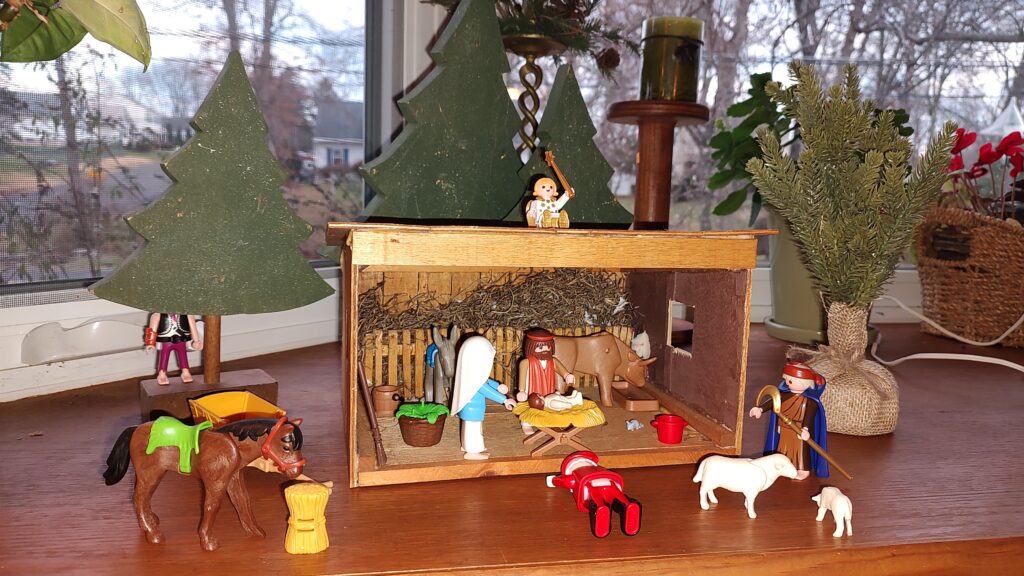The Glory-Filled Details of Christmas
Christmas and Hanukkah: God Always Provides
School Board President Urges Usage of ‘Christmas’
The Miraculous Christmas Truce
Lab-Leak Proof: COVID ‘Blueprint’ Discovered
The Glory-Filled Details of Christmas
Joseph also went up from Galilee, out of the city of Nazareth, into Judea, to the city of David, which is called Bethlehem, because he was of the house and lineage of David, to be registered with Mary, his betrothed wife, who was with child. So it was, that while they were there, the days were completed for her to be delivered. And she brought forth her firstborn Son, and wrapped Him in swaddling cloths, and laid Him in a manger, because there was no room for them in the inn. Now there were in the same country shepherds living out in the fields, keeping watch over their flock by night. And behold, an angel of the Lord stood before them, and the glory of the Lord shone around them, and they were greatly afraid. Then the angel said to them, “Do not be afraid, for behold, I bring you good tidings of great joy which will be to all people. For there is born to you this day in the city of David a Savior, who is Christ the Lord. And this will be the sign to you: You will find a Babe wrapped in swaddling cloths, lying in a manger” (Luke 2:4–12).
Get prayer updates from IFA.
Several years ago in early December, I was shopping, as I often do, in a local thrift store. At checkout I spied a bag of Playmobil figurines hanging on a pegboard. I quickly grabbed it, reasoning that the price was exceptional and the content would add to the stash for my kids and grandkids. At home I emptied my find onto the coffee table and broke into a delighted grin. This was a full nativity set: Mary, Joseph, Baby Jesus, a manger, a donkey, a horse, a shepherd, and two sheep, plus feeding troughs, hay, a cart, a mouse, three wise men and their gifts, a camel — and Santa and a pirate. Hmm … my children joined me in gaping with glee, and that pirate and Santa quickly became favored additions to our Christmas story yearly, as we hid the pirate for little ones to find, and as Santa bowed at Jesus’ feet in adoration.

For my son Mitchell, a scholar and a stickler for biblical details, the wise men were the most fun. He insisted that we put them in the basement, moving them up the stairs progressively after Christmas day, to represent the roughly two-year gap between Messiah’s birth and their own appearance in Bethlehem (Matthew 2:1–12). It was important to my son, and to me, that the full richness of the details of the story be appreciated and acted out. In cinematic depictions, and for brevity, everything happens in an hour, though in reality this earth-shattering event — God made flesh and entering our sin-broken world as a vulnerable baby — was enacted over a longer period, with each person’s role being vital to God’s unfolding plan to redeem creation and those made in his image.

I do not believe in deconstructing the biblical narrative as it has been presented as a mere academic exercise, but rather, I revel in fleshing out the details that are often eclipsed by modernity and our Western worldview.
The Inn and the Stable
In 2018, I read Jesus Through Middle Eastern Eyes: Cultural Studies in the Gospel, by Dr. Kenneth E. Bailey. This author is an expert in Middle Eastern New Testament studies, and he publishes in English and Arabic, having lived in the Middle East for decades. In the chapter titled “The Story of Jesus’ Birth,” Bailey clarifies the “no room at the inn” issue. He first explains how, in that culture, Joseph’s returning to his hometown, given his Davidic lineage, would have meant that most homes would have been open to him and his pregnant wife. He explains that Yosef (his Hebrew name) was a kind of royalty, being a direct descendant of David. Bethlehem is often called, even today, the city of David. There is no way that they were shuffled off into some barn, denying them all hospitality. The Middle Eastern world is culture where hospitality is taken very seriously as a matter of honor. Luke 2:6 declares that while they were there, “the days were completed” for Miryam (her Hebrew name) to be delivered. Bailey explains that Joseph would never have been expected or required to deliver the baby, and that it was not an urgent matter upon their arrival.
Next, he addresses the idea of a barn for the housing and birth, as being inconsistent with both historical evidence in Bethlehem and modern-day practices. The majority of homes in Bethlehem (remembering that this was a city of farmers and shepherds) had a room attached to the house, in which the animals were kept. This offered the advantage in winter of the animals’ body heat providing warmth to the dwellers. This space was typically on the lowest level, and then, up a short flight of steps, there was a larger room in which the family lived, ate, and slept. At the joining of these two rooms, troughs were made for the animals to feed. These were called mangers. A wealthier family might have had an extra room for guests. Interestingly, this room was called an “inn.”
Now, consider the “no room at the inn” idea: I always imagined that it was like arriving at a motel to find a No Vacancy sign lit up. This idea is ludicrous in view of the realities of Middle Eastern hospitality. The word translated “inn” in Luke 2 is the Greek word katalyma. This is not the word for a commercial inn (which is pandocheion, as in the Luke 10 account of the good Samaritan). The katalyma’s being too full could refer to any number of “places to stay.” Luke uses the same word later, when Jesus needs a place to observe the Passover feast with his disciples (Luke 22:10–11). In this case, the reference is to an upper room.
Why should any of this matter? Nit-picking word meanings for their own sake may be a “religious” activity; digging deeper into the glorious realities of this God child’s arrival, on the other hand, brings worship and awe. The town was full because of everyone’s arrival in response to Herod’s census. But Mary and Joseph were welcomed and given accommodation within a relative’s home that was already brimming with guests! The animals were probably turned out, and that room was made ready for them and for the arrival of the baby. The village midwife and other women would have assisted during the birth, while Joseph awaited outdoors with the other men in his extended family. The baby was then laid upon fresh straw in those manger troughs and wrapped in the swaddling cloths.
Shepherds, Swaddling Cloths, and Messianic Identity
Now, one final glorious puzzle piece brought to me by a dear missionary friend: We are all familiar with the appearance of angels to those lowly shepherds watching over their sheep by night — those chosen recipients of not just angelic visitation, but also of messaging and song in announcement of the Christ child’s birth. But were these just normal shepherds? How did the shepherds know exactly where to look for this baby in Bethlehem? And what, exactly, are swaddling cloths?
The shepherds chosen to receive that gospel news in the narrative were no run-of-the-mill Israelite shepherds. They were those appointed by the priests in Jerusalem to provide the sacrificial lambs needed in temple sacrifice throughout the year, especially at Passover. They had special qualifications to preserve these lambs spotless and without blemish until the time of the sacrifice (Exodus12:5;13:2). This being the case, Jesus’ birth could easily have occurred in one of the stalls in these shepherds homes, set aside for the lambs. There was “no room for them in the inn,” but the lamb stalls were attached to the homes and would have been a possible location for the birth. What a glorious foreshadowing of our Savior’s role as the Lamb of God Who would take away the sins of the world!
The direction given to these shepherds was specific, telling them to look in the city of David for “a baby wrapped in swaddling cloths and lying in a manger.” That word translated manger is used in both testaments (phatne in Greek; urvah in Hebrew) to describe a stall for an animal (Habakkuk 3:17; 2 Chronicles 32:28). And those cloths that I had imagined were used for all human newborns were actually the cloths used by shepherds to wrap their sacrificial lambs directly after their birth — if the animals were considered to meet the Mosaic requirements for a perfect sacrifice. Yeshua, our perfect sacrifice (Hebrews 10:12,14), was born exactly where the sacrificial lambs were born, and He was wrapped in the cloths used for those perfect lambs. My heart and soul delight in my God as I see His elaborate planning!
What does all of this have to do with my random pirate? He was a blessed accident of packaging, but we wove him into our birth narrative just for sheer delight! The wisemen, on the other hand, were banished to “the east” to await their time to arrive and to bring their gifts to the Babe — gifts that spoke of His destiny and identity. And so, these details of the birth narrative (the inn, the manger, the swaddling cloths, the shepherds) all add awe and richness to the supernatural plan of God in bringing forth this Jewish child in a specific place, at a specific time (probably in the spring, but that is a topic for another post), and being brought to the attention of a very specific group of shepherds, who would recognize Him as the Messiah. Did this help sustain them when, two years later, wicked Herod robbed them of their infant sons? My heart does hope so.
As for us, as we enter this festive season, may we take time to worship the God of the details and to connect more deeply with our Jewish Messiah, Whose birth heralded “on earth peace, goodwill toward men!”
Has this article been a blessing to you? Share it with others, and bless them, too!
Author Lori Meed is an IFA intercessor who shares her wisdom and intercessory insight on Pray With Others LIVE. Join us Tuesdays at 12:15 p.m. ET for a time of praying together for God’s purposes in our nation, covering the top issues and prayer needs from Headline Prayer. Photo Credit: Lori Meed.
Partner with Us
Intercessors for America is the trusted resource for millions of people across the United States committed to praying for our nation. If you have benefited from IFA's resources and community, please consider joining us as a monthly support partner. As a 501(c)3 organization, it's through your support that all this possible.


We use cookies to ensure that we give you the best experience on our website. If you continue to use this site we will assume that you are happy with it. Privacy Policy




Comments
No comments have been posted yet; you can be the first!